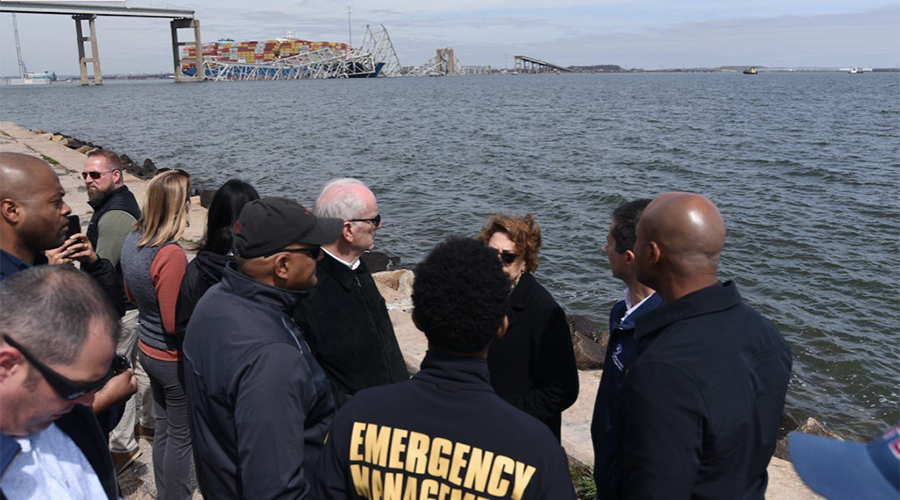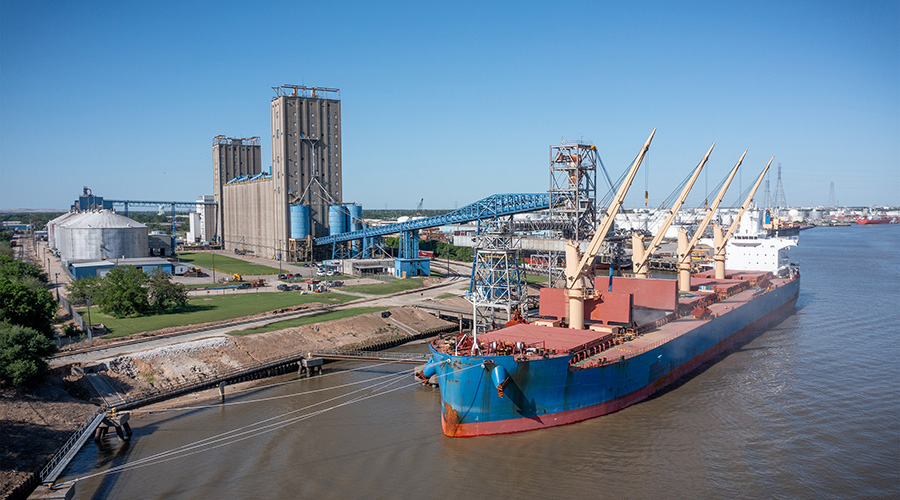CSX, NS prepare for rerouting traffic at Baltimore port
3/28/2024
By Julie Sneider, Senior Editor
CSX and Norfolk Southern Railway are working with customers, the Port of Baltimore and state officials to respond to shipment delays as a result of Tuesday’s collapse of the Francis Scott Key Bridge and the port’s closure.
Both Class Is provide intermodal service from the port, which is one of the largest in the United States. Vessel traffic into and out of the port is suspended until further notice, but trucks are still being processed inside port terminals.
The bridge collapsed about 1:30 a.m. Tuesday after it was struck by a Maersk-chartered container ship. The incident took the lives of six construction crew members who were performing repairs on the bridge when it collapsed.
The National Transportation Safety Board, which is investigating the incident with the support of the U.S. Coast Guard, yesterday released this video of aerial imagery at the scene.
CSX said its customers should anticipate potential shipment delays.
“While freight traffic has not been entirely halted in the region, certain commodities have been affected by the incident. CSX is actively communicating with customers to provide updates on their shipment statuses as the situation evolves,” CSX officials said in a prepared statement.
 “This is going to be different than what America experienced in 2021 with the backups on the West Coast ports, but similarly [the situation at Baltimore] will lead to a lot of complications for our supply chain.” — U.S. Transportation Secretary Pete Buttigieg, shown here second from the right as he met with Maryland state, Baltimore city and Port of Baltimore officials to view the collapsed Francis Scott Key Bridge. Secretary Pete Buttigieg’s profile on X
“This is going to be different than what America experienced in 2021 with the backups on the West Coast ports, but similarly [the situation at Baltimore] will lead to a lot of complications for our supply chain.” — U.S. Transportation Secretary Pete Buttigieg, shown here second from the right as he met with Maryland state, Baltimore city and Port of Baltimore officials to view the collapsed Francis Scott Key Bridge. Secretary Pete Buttigieg’s profile on XCSX has the capacity to dispatch additional trains to CSX-served coal terminals in Baltimore before reaching pile space limits. Contingency plans are being put into place, and CSX is in contact with coal customers at those terminals.
“The company currently intends to keep its Curtis Bay Coal Pier facility operational but will continue to assess the circumstances to determine appropriate actions moving forward,” CSX officials said.
Because all international intermodal shipments destined for Baltimore have been suspended temporarily, CSX is working with its international customers to identify alternative solutions to support cargo movement to and from Baltimore.
“It's important to note that domestic intermodal traffic on CSX destined for local Baltimore remains unaffected,” company officials said.
CSX President and CEO Joe Hinrichs noted that Baltimore and the state of Maryland have been central to the railroad’s operations for nearly two centuries.
“We remain deeply connected to this dynamic region. We stand in solidarity with the community during this difficult time,” Hinrichs said.
Meanwhile, NS is working with customers to find alternative routes. The Class I’s network serves all the major East Coast ports, which have the capacity to serve the flow of freight, NS officials said in a prepared statement.
 An image from an NTSB video of the collapsed bridge and the damaged cargo ship at the Port of Baltimore. National Transportation Safety Board
An image from an NTSB video of the collapsed bridge and the damaged cargo ship at the Port of Baltimore. National Transportation Safety Board“Our network touches every major port on the eastern seaboard, and we have proactively reached out to help our customers and provide alternate routing solutions,” according to the statement. “Significant supply chain events demand a rapid response approach, frequent communication and innovative solutions, and Norfolk Southern is doing all three of these things to help our customers and partners navigate through this challenge.”
It’s too soon to assess the long-term business impact on the rail industry, said Rand Ghayad, Association of American Railroads’ senior vice president of policy and economics.
“However, recent years have shown us the resilience of railroads and the broader logistics sector in adapting swiftly to challenges while continuing to serve our customers,” Ghayad said in a press release. “Those lessons will be put to work in the days ahead to minimize disruption to the fullest extent possible.”
The port’s closure will cause a ripple in the nation’s supply chain, but how big of an impact and for how long remains to be seen, said U.S. Transportation Secretary Pete Buttigieg.
“It's not the only port on the East Coast, but [the Port of Baltimore] does have some unique capabilities,” Buttigieg said in a media interview posted on X, formerly known as Twitter. “This is going to be different than what America experienced in 2021 with the backups at the West Coast ports, but similarly [the situation at Baltimore] will lead to a lot of complications for our supply chain.”
The Port of Baltimore is the largest port in the country for handling automobiles, light trucks, roll on/roll off heavy farm and construction machinery, imported sugar and imported gypsum. It’s ninth among major U.S. ports for foreign cargo handled; and ninth for total foreign cargo value, according to port officials.
In 2023, the port handled 847,158 cars and light trucks — the 13th consecutive year that it led all other U.S. ports in that commodity. The port also set records last year for other types of cargo handled, including:
• 52.3 million tons of foreign cargo; the previous record was 44.2 million tons in 2019;
• $80.8 billion in foreign cargo value, up from the previous record of $74.3 billion in 2022;
• 1.3 million tons of roll on/roll off farm and construction machinery, up from the most recent record, 1 million tons, set in 2012;
• 1.1 million 20-foot equivalent unit containers, up from a record 1 million TEUs in 2019; and
• 11.7 million tons of general cargo tons, up from 11.3 million tons in 2022.
The port’s increasing container business is expected to be further boosted by the CSX-owned Howard Street Tunnel expansion project, port leaders said in their 2023 year-end press release. The project will be designed to allow double-stacked container rail cars and enable seamless double-stack capacity from Maine to Florida. The expansion calls for clearance improvements in the 127-year-old tunnel and at 21 other locations between Baltimore and Philadelphia.
Slated to be completed in 2027, the tunnel expansion is expected to increase the port’s business by about 160,000 containers annually, port officials say.
As for the Key Bridge, President Biden said it’s his intention that the federal government will fund the entire cost of rebuilding it. The structure is “critical” for travel through the Northeast Corridor and an important element in the Northeast economy, the president noted.
His administration will work with Congress to “make sure the state gets the support it needs,” he said, adding that reconstructing the bridge will take time. In a March 28 White House press briefing, Buttigieg said the U.S. Department of Transportation is focused on reopening the port; dealing with supply-chain implications until it does reopen; rebuilding the bridge; and dealing with the surface transportation implications until the bridge is rebuilt.
How long it will take to rebuild it isn’t yet known, nor are dollar estimates available, Buttigieg said.
“Rebuilding will not be quick, or easy or cheap, but we will get it done,” he added.

